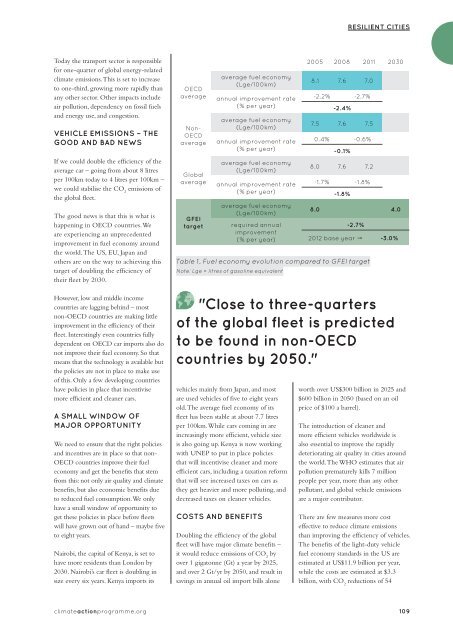Climate Action 2014-2015
You also want an ePaper? Increase the reach of your titles
YUMPU automatically turns print PDFs into web optimized ePapers that Google loves.
RESILIENT CITIES<br />
Today the transport sector is responsible<br />
for one-quarter of global energy-related<br />
climate emissions. This is set to increase<br />
to one-third, growing more rapidly than<br />
any other sector. Other impacts include<br />
air pollution, dependency on fossil fuels<br />
and energy use, and congestion.<br />
VEHICLE EMISSIONS – THE<br />
GOOD AND BAD NEWS<br />
If we could double the efficiency of the<br />
average car – going from about 8 litres<br />
per 100km today to 4 litres per 100km –<br />
we could stabilise the CO 2<br />
emissions of<br />
the global fleet.<br />
The good news is that this is what is<br />
happening in OECD countries. We<br />
are experiencing an unprecedented<br />
improvement in fuel economy around<br />
the world. The US, EU, Japan and<br />
others are on the way to achieving this<br />
target of doubling the efficiency of<br />
their fleet by 2030.<br />
However, low and middle income<br />
countries are lagging behind – most<br />
non-OECD countries are making little<br />
improvement in the efficiency of their<br />
fleet. Interestingly even countries fully<br />
dependent on OECD car imports also do<br />
not improve their fuel economy. So that<br />
means that the technology is available but<br />
the policies are not in place to make use<br />
of this. Only a few developing countries<br />
have policies in place that incentivise<br />
more efficient and cleaner cars.<br />
A SMALL WINDOW OF<br />
MAJOR OPPORTUNITY<br />
We need to ensure that the right policies<br />
and incentives are in place so that non-<br />
OECD countries improve their fuel<br />
economy and get the benefits that stem<br />
from this: not only air quality and climate<br />
benefits, but also economic benefits due<br />
to reduced fuel consumption. We only<br />
have a small window of opportunity to<br />
get these policies in place before fleets<br />
will have grown out of hand – maybe five<br />
to eight years.<br />
Nairobi, the capital of Kenya, is set to<br />
have more residents than London by<br />
2030. Nairobi’s car fleet is doubling in<br />
size every six years. Kenya imports its<br />
OECD<br />
average<br />
Non-<br />
OECD<br />
average<br />
Global<br />
average<br />
GFEI<br />
target<br />
average fuel economy<br />
(Lge/100km)<br />
annual improvement rate<br />
(% per year)<br />
average fuel economy<br />
(Lge/100km)<br />
annual improvement rate<br />
(% per year)<br />
average fuel economy<br />
(Lge/100km)<br />
annual improvement rate<br />
(% per year)<br />
average fuel economy<br />
(Lge/100km)<br />
required annual<br />
improvement<br />
(% per year)<br />
"Close to three-quarters<br />
of the global fleet is predicted<br />
to be found in non-OECD<br />
countries by 2050."<br />
vehicles mainly from Japan, and most<br />
are used vehicles of five to eight years<br />
old. The average fuel economy of its<br />
fleet has been stable at about 7.7 litres<br />
per 100km. While cars coming in are<br />
increasingly more efficient, vehicle size<br />
is also going up. Kenya is now working<br />
with UNEP to put in place policies<br />
that will incentivise cleaner and more<br />
efficient cars, including a taxation reform<br />
that will see increased taxes on cars as<br />
they get heavier and more polluting, and<br />
decreased taxes on cleaner vehicles.<br />
COSTS AND BENEFITS<br />
Doubling the efficiency of the global<br />
fleet will have major climate benefits –<br />
it would reduce emissions of CO 2<br />
by<br />
over 1 gigatonne (Gt) a year by 2025,<br />
and over 2 Gt/yr by 2050, and result in<br />
savings in annual oil import bills alone<br />
2005 2008 2011 2030<br />
8.1 7.6 7.0<br />
-2.2% -2.7%<br />
-2.4%<br />
7.5 7.6 7.5<br />
0.4% -0.6%<br />
-0.1%<br />
8.0 7.6 7.2<br />
-1.7% -1.8%<br />
-1.8%<br />
8.0 4.0<br />
-2.7%<br />
2012 base year -3.0%<br />
Table 1. Fuel economy evolution compared to GFEI target<br />
Note: Lge = litres of gasoline equivalent<br />
worth over US$300 billion in 2025 and<br />
$600 billion in 2050 (based on an oil<br />
price of $100 a barrel).<br />
The introduction of cleaner and<br />
more efficient vehicles worldwide is<br />
also essential to improve the rapidly<br />
deteriorating air quality in cities around<br />
the world. The WHO estimates that air<br />
pollution prematurely kills 7 million<br />
people per year, more than any other<br />
pollutant, and global vehicle emissions<br />
are a major contributor.<br />
There are few measures more cost<br />
effective to reduce climate emissions<br />
than improving the efficiency of vehicles.<br />
The benefits of the light-duty vehicle<br />
fuel economy standards in the US are<br />
estimated at US$11.9 billion per year,<br />
while the costs are estimated at $3.3<br />
billion, with CO 2<br />
reductions of 54<br />
climateactionprogramme.org 109












